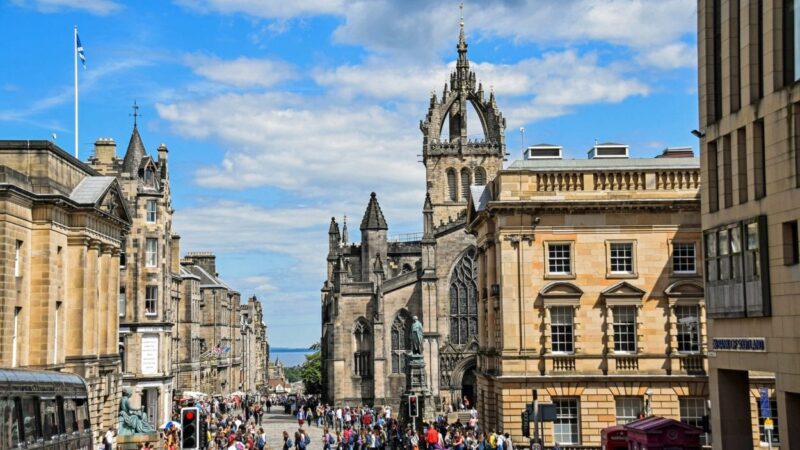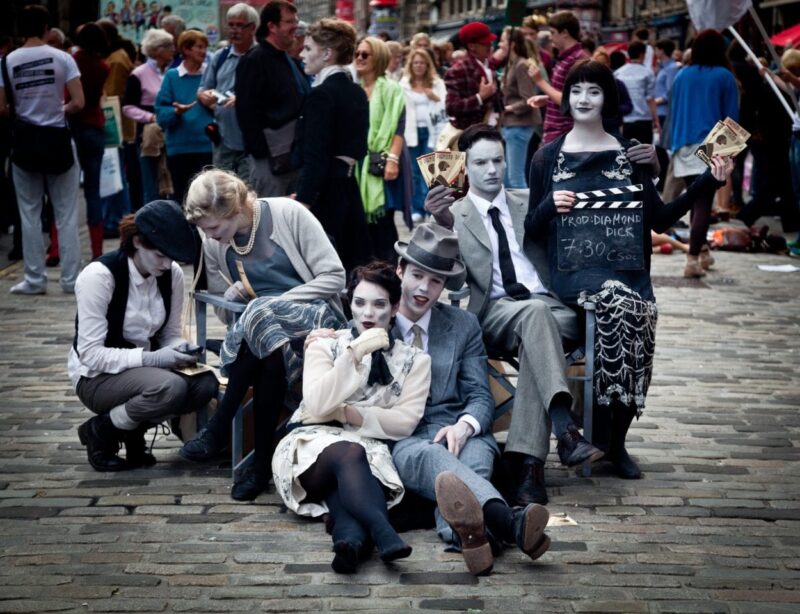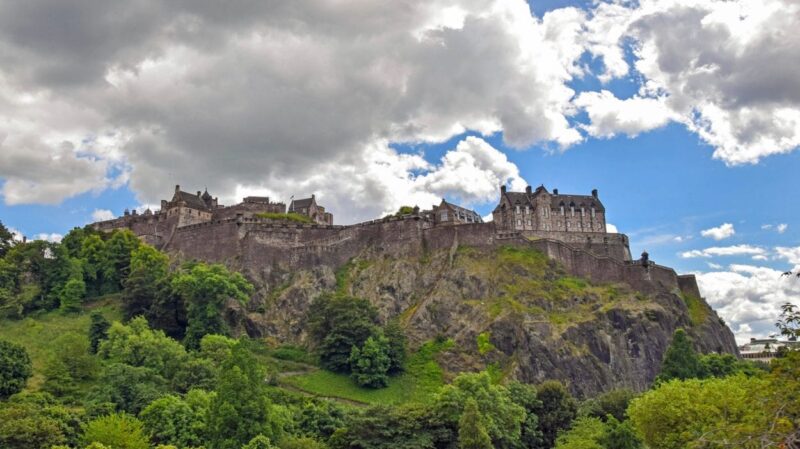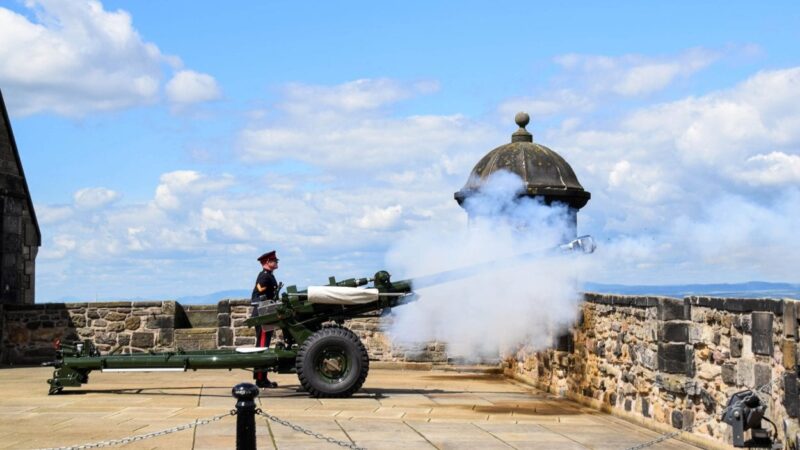1. Visit the Royal Mile
ncluding the Royal Mile in your two-day trip to Edinburgh is an absolute must, as this historic thoroughfare serves as a captivating artery connecting the city’s past and present. Stretching approximately one mile, the Royal Mile winds its way through the heart of the Old Town, leading from Edinburgh Castle at one end to the Palace of Holyroodhouse at the other.
This enchanting stretch of cobblestone streets offers a myriad of shops, each a treasure trove of Scottish craftsmanship and heritage. From traditional kilts and tartans to exquisite jewelry and Scotch whisky, the shops lining the Royal Mile provide a perfect opportunity to immerse yourself in Scotland’s cultural tapestry and take home unique souvenirs.
As you explore, be sure to visit the Writers’ Museum, tucked away in one of the Royal Mile’s historic buildings, paying homage to Scotland’s literary greats such as Robert Burns, Sir Walter Scott, and Robert Louis Stevenson. The street itself is a living museum, adorned with medieval architecture and dotted with landmarks like St. Giles’ Cathedral, adding a touch of grandeur to your stroll.
Not only does the Royal Mile offer a delightful shopping experience, but it also serves as a vibrant stage for street performers, artists, and the city’s festivals. Engage with bagpipers playing traditional tunes or stop to watch a captivating street performance, adding a dynamic and lively atmosphere to your Edinburgh adventure.
Fun fact: The Royal Mile is technically longer than a mile, measuring around 1.12 miles (1.8 kilometers). Its rich history dates back to the medieval era, and the street has witnessed the comings and goings of royalty, poets, and traders over the centuries. Exploring the Royal Mile is a journey through time and culture, making it an essential stop for a comprehensive and immersive experience during your two-day stay in Edinburgh.
Tartan: Weaving the Threads of Scottish Heritage
Tartan, with its distinctive crisscross pattern of intersecting horizontal and vertical bands, stands as a symbol deeply intertwined with the rich history and cultural heritage of Scotland. The roots of tartan can be traced back centuries, and its evolution tells a compelling story of Scottish identity and craftsmanship.
The origin of tartan dates back to the Scottish Highlands, where local communities began weaving woolen fabric with natural dyes, creating distinctive patterns unique to each clan or region. These early forms of tartan were functional, serving as both clothing and a form of identification, as specific patterns were associated with particular families or areas.
The turning point for tartan came in the 18th century when it gained popularity beyond Scotland’s borders. The romanticized view of the Highlands, fueled by literature and the royal visit of King George IV to Edinburgh in 1822, sparked a broader fascination with Scottish culture. Tartan became a symbol of Scottish pride and a fashion statement, adorning not only kilts but also various accessories and clothing items.
The Victorian era witnessed a surge in the popularity of tartan patterns, with Queen Victoria herself contributing to the trend by dressing her children in Highland attire. The establishment of the Scottish Tartans Society in the mid-20th century further formalized the identification and registration of tartan patterns, ensuring their preservation and authenticity.
Today, tartan remains a vibrant symbol of Scottish heritage, and its patterns continue to be associated with clans, regions, and institutions. The diversity of tartans reflects the myriad connections to Scotland’s past, from military regiments to academic institutions and commercial brands. The enduring appeal of tartan transcends mere fashion; it serves as a tangible link to Scotland’s storied past, weaving together threads of tradition, identity, and pride. Whether worn in a kilt or celebrated in various forms of design, tartan remains a living testament to the enduring spirit of Scottish culture.
2. Watch some Fringe Festival Shows
The Edinburgh Festival Fringe, an unmissable highlight in the cultural calendar, transforms Scotland’s capital into a vibrant stage for performers from around the globe. Taking place annually in August, the festival complements the city’s historic charm with an explosion of creativity and showcases a diverse array of performances across various genres.
Throughout the festival, the city becomes a bustling hub of artistic expression, with an eclectic mix of theater, comedy, music, dance, and spoken word performances. From established artists to emerging talents, the Fringe provides a platform for a multitude of voices, ensuring an unparalleled and inclusive cultural experience.
One of the distinctive features of the Edinburgh Festival Fringe is its accessibility. While some shows may require ticket purchases, the festival also embraces the spirit of free and open-access performances, allowing attendees to stumble upon hidden gems in unexpected corners of the city. This accessibility fosters an atmosphere of discovery, where attendees can explore a multitude of performances without breaking the bank.
Incorporating the Edinburgh Festival Fringe into a two-day trip to the city is a brilliant decision for several reasons. Firstly, the sheer diversity of shows ensures that there’s something for every taste, whether you’re drawn to thought-provoking dramas, uproarious comedies, or avant-garde experimental performances. Secondly, the festive atmosphere that permeates the city during the Fringe adds an extra layer of excitement to your visit, creating an immersive and dynamic cultural experience.
Beyond the entertainment, the Edinburgh Festival Fringe offers a unique opportunity to engage with the global artistic community, fostering connections and memories that linger long after the curtain falls. Whether you’re a seasoned festival-goer or a first-time attendee, the Edinburgh Festival Fringe promises an unforgettable and enriching two-day adventure, where every street corner may unveil a new and captivating performance, making your visit to Edinburgh an extraordinary cultural escapade.
3. Visit the Edinburgh Castle
Perched atop the volcanic Castle Rock, Edinburgh Castle stands as an iconic symbol of Scotland’s rich and storied past, casting its majestic silhouette against the city’s skyline. Steeped in history and surrounded by breathtaking views, a visit to Edinburgh Castle is an essential component of any trip to the Scottish capital.
Cost of Admission: While the cost of admission may vary, a ticket to Edinburgh Castle typically includes access to various attractions within the castle complex. Visitors can explore the Crown Jewels, the Stone of Destiny, the National War Museum, and the Great Hall, among other historic sites. The ticket prices often include guided tours and exhibitions, providing a comprehensive experience of the castle’s heritage.
History: The history of Edinburgh Castle spans centuries, dating back to at least the 12th century. The castle has witnessed pivotal moments in Scottish history, serving as a royal residence, a military stronghold, and a symbol of authority. Its strategic location made it a crucial fortification during conflicts between Scotland and England. The castle has hosted numerous monarchs, including Mary Queen of Scots, and played a central role in events such as the Wars of Independence.
Interesting Facts:
- The One O’Clock Gun: One of the castle’s unique traditions is the firing of the One O’Clock Gun, a daily event that dates back to 1861, providing a time signal to ships in the Firth of Forth.
- The Honours of Scotland: Edinburgh Castle is home to the Honours of Scotland, comprising the Crown Jewels – the Crown, Sceptre, and Sword of State. These artifacts play a significant role in Scottish coronation ceremonies.
- The Stone of Destiny: Housed in the Crown Room, the Stone of Destiny, also known as the Stone of Scone, is a symbol of Scottish kingship and has been used in coronation ceremonies for centuries.
- The Castle’s Military Legacy: The castle’s military legacy is evident in its various military museums and memorials, including the National War Museum, showcasing Scotland’s military history.
A visit to Edinburgh Castle immerses you in the captivating narrative of Scotland, offering a glimpse into its royal past, military prowess, and cultural significance. As you traverse its historic grounds, you’ll be transported through the annals of time, discovering the tales that have shaped this formidable fortress into the cultural gem it is today.
Tips for the Cannon Firing at Edinburgh Castle
- Show up early – Make sure you show up and get a good front row position (30 minutes to an hour early). As the cannon firing is a very popular destination and only occurs once a day.
- Enjoy the Edinburgh castle before the firing – a lot of people walk around the castle after the ceremony – I recommend showing up well before the ceremony so that you will already be on the castle grounds and then head over to the event thirty minutes to an hour prior.
- Bring ear protection – this is a cannon, it will be loud. If you, or someone you are traveling with, has sensitive ears then I encourage bringing some form of ear protection.
4. Watch the Royal Edinburgh Military Tattoo
The name is not as it sounds. It is not a festival for body art! The phrase “tattoo” comes from a Dutch phrase to turn off the tap “doe den tap toe”. Every night drums would signify the time to turn off the taps and for the Soldiers to return to their quarters. Now, what is more fitting for land of whiskey and scotch to have a festival after that? Since then the Royal Edinburgh Military Tattoo was born.
The Royal Edinburgh Military Tattoo is performances from bands of the United Kingdom forces, Commonwealth countries, and other international armed forces. Typically each band performs a set and there is a story or a theme. When I went during the 2017 show here were some of the stories.
- The United States Naval Forces Europe Band: Drunken sailor trying to get home
- Japan Ground Self-Defence Force Central Band: Samurai fight (their first appearance!)
- Fanfare Band of the 9th French Marine Infantry Brigade: Tribute to Daft Punk
I recommend purchasing tickets in advance as people travel worldwide to see this show. There are also different package options. I opted for a whiskey package where you dine at the Edinburgh castle.
During this special event, a piper pipes in the haggis. Then you eat a three-course meal with various whiskey. Once you have your hour to two-hour meal course, you walk down to see the Military Tattoo show! It was a great experience. Check out tickets to the military tattoo here!
The show typically takes place from the beginning of August (~3 August) to the end of August (~25 August) making it perfect for two days in Edinburgh, Scotland during August.
Tips for the Edinburgh Military Tattoo
- Purchase tickets in advance – the show is popular and not only do people from Scotland and England travel to see it but worldwide. I people I met during my trip were from Australia and the United States.
- Look for a clan night – if you come from a Scottish heritage the military tattoo will also offer clan nights. That is when two clans will walk in to start the ceremony. All will be wearing their clan tartan colors. Check out the website to see if there is a scheduled day for your name.
- Dress warm – the event takes place outdoors – which means that it can get a bit chilly. Even though the event takes place in August the temperatures can drop at night time. Bring a warm coat or a throw blanket to stay warm during the performance.
- Arrive early – if you are not participating in the pre-show events like the whiskey tasting, or meal options – then arrive early to the event. There is only one entrance to the castle and when everyone shows up it becomes very crowded trying to enter and present your ticket. Make sure you arrive no less than thirty minutes before the start of the show.
- Visit Edinburgh Castle at the beginning of the day – the castle closes leading up to the performance. You will not be able to double dip and walk around the castle and then go to the show. The authorities close down the road to the castle for about two hours in advance. So unless you have a reservation at one of the restaurants up the hill then you will not be allowed access until the doors are open for the Edinburgh military tattoo.
Follow these tips and you will be prepared for an evening of festivities. The Edinburgh military tattoo is a must see in Edinburgh.
4. Visit the Edinburgh International Book Festival
Additionally occurring in August is the Edinburgh International Book Festival. From about mid-August (~11 August) to the end of August (~27 August) Edinburgh hosts there international book festival.
Did you know that Edinburgh was inducted into the UNESCO City of Literature in 2004? Edinburgh, like Dublin, is another famous European city for literary masters. You can find a lot of literary history in the city.
In the words of Scottish poet Hugh MacDiarmid, ‘Edinburgh is a mad god’s dream.’
The International Book Festival is in the center of Edinburgh. Typically at one of the parks will be large popup tents with different book selections. It is basically like walking into a book store! In the park will be a variety of author visits and reading sessions so if you like a particular author I would check out if they will be doing any readings or signings at the event.
There is no cost to enter into the event – and books at the event cost as much as ones at a normal book store. However, the Bookfair seems to hold a lot more “unique” copies of books – meaning special edition that make the books a bit more special than the normal hardback or paper copy you find at normal bookstores.
This makes a great gift from Scotland and is an Edinburgh must see.
Try to snatch a copy of some of these famous Scottish writers:
- Robert Louis Stevenson – Strange Case Of Dr. Jekyll And Mr. Hyde, Treasure Island
- J.M. Barrie – Peter Pan
- Sir Arthur Conan Doyle – Sherlock Holmes
- Sir Walter Scott – Rob Roy, The Lady of The Lake
5. Visit Greyfriars Bobby and the Monument to Sir Walter Scott
Now to finish up the Two Days in Edinburgh, Scotland during August is some quick visits to famous structures in Edinburgh.
First is Greyfriars Bobby, a famous dog statue in Edinburgh. The famous Skye terrier, Greyfriars Bobby, is known for having stood guard of his owners grave for 14 years before he too finally passed away. It had become popular to rub the dog’s nose for luck, but actually, Scottish officials are asking the tourist to stop the trend in order to stop the wearing away of the dog’s nose.
The second is the Monument to Sir Walter Scott. The monument is in Victorian Gothic architecture and was erected to honour the late Sir Walter Scott. The monument resides in the city of Edinburgh, with 287 stairs to the top.
Getting around Edinburgh
The main attractions are all located in the center of Edinburgh. I found that I was able to walk to all the destinations with at most a 30-minute walk.
You will find there are so many shops and things to look at along the way that a walk from one side of the town center to the opposite side does not feel like thirty minutes. You will find a lot of parks along the routes that you can stroll through instead of walking on the surface streets.
However, if you are in more of a rush you can always take a taxi or an uber to the various locations around town.







Edinburgh looks so amazing! Have seen some awesome photos from there!
The Royal Edinburgh Military Tattoo looks really fun. I would love to attend it. And of course, the castle too. Thanks for this post. Bookmarked it for a later time 🙂
I’ve always wanted to go to the Edinburgh International Book Festival. I’ll have to mark those dates on my calendar. Great list!
This is lovely. I’ve wanted to do a trip through Scotland for a while. I’ll have to add Edinburgh to it for sure. Especially for the book festival.
The Military Tattoo sounds like such a cool experience! I was briefly in Edinburgh years ago but would love to go back… saving this for whenever I return!
Great post- I went during New Years , but looks like there is tons to do over Summer- love the cost breakdown and varied options … the Fringe festival must be amazing!!
Awwwww, I love Edinburgh. I’ve only been twice and it was specifically for the Fringe festival which is absolutley amazing. I need to go back and see some of the other stuff. I walked up the Royal Mile to the outside of the castle but I’d love to go inside. Fab post, thanks for sharing.
OH my! I would love to visit a castle such as that. Fabulous post on specifics down to the cost. Thanks!
You just planned out a whole itinerary for me! Thanks! Can’t wait for my trip!
Oooh you were so lucky with the weather! I blooming love Edinburgh but I’ve seen it in the rain way more than days with beautiful fluffy clouds like that!!
The one thing I’d love to do (but whenever I have time, it’s just too wet) is climb up to Arthurs Seat. Imagine seeing the city from up high on days as nice as that!
Love this! I will definitely save this for when I am visiting Europe again next year!
I’m missing some of these great activities (hello, international book festival!) by two months, but I’m sure I’ll make a return visit to Edinburgh while I’m living in the UK. Also, love the sky in the featured photo 🙂
I love Fringe festivals! I’d go back to Edinburgh just for that. Thanks for the idea!
OMG! I been dreaming about Edinburgh for ages.. Bookmarking it for when I am there hopefully end of this year!
What! I’ve never heard of the International Book Festival, but that honestly sounds awesome enough to make a trip out of that alone!
I’m not going to lie- I got really food poisoning last time I was in Edinburgh and basically spent a ton of my time inside my room- that said, I really really want to go back soon, and your post reminded of how many cool places there are visit!
[…] Learn about visiting Edinburgh, Scotland here! A great second city location to visit after Dublin due to proximity. […]
Loved this post, your photos and information provided are fantastic. I have pinned for future reference.
[…] the grate of the bowl then you will be granted good luck! This is similar to rubbing the nose of Greyfriars Bobby in Edinburgh for luck or tossing a coin into the Trevi Fountain in Rome to return. However, getting the coin from the […]
[…] course, this is just a fun visitor thing to do and is similar to other attractions like Edinburgh’s Greyfriars Bobby or Porcellino in […]